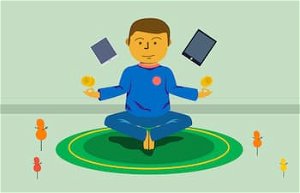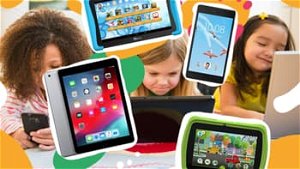
If you pick up a tablet at your local electronics store or online, there’s a good chance it’s running Apple’s iOS or
Google’s Android operating system. Understanding what each operating system offers is a simple way to decide which
tablets are best for you.
For basic media consumption or kids, we think the Amazon Fire HD 8 is an ideal option.
For everything else, the iPad 10.2 (2020) is a solid all-around choice.
But if you’re looking for more information about how these two popular operating systems -- and the tablets running them -- stack up, we’ll cover everything you need to know in this guide.
Editor’s Note: This post has been updated for 2022
The Pros and Cons of Apple’s iPads
PROS
Easy to use, consistent software
With basic organization and an easy-to-learn interface, you can get comfortable with your tablet quickly. Better still, the interface is similar across all iOS devices. So if you have an iPhone already or upgrade to a new tablet later, using another iOS device should feel familiar.
Excellent quality (even on the lowest models)
With metal cases, flush screens, and a sleek design, iPads are some of the best-made tablets available in terms of finish and premium feel.
Superior performance (even on the lowest models)
The entry-level iPad -- the iPad 10.2 (2020) can play games, multi-task, and stream HD video with ease and performance only increases from there.
Screened app store
Apple approves every app in the iTunes App Store. This means you can always trust apps to work well and not worry about malware or bugs.
More “high-end” apps
MacOS has a reputation for being the best choice for creatives and content producers. The iPad is no exception with an excellent selection of graphic design, video editing, audio editing, and other productivity-centric apps.
Great for gaming
While Android has some awesome games, some of the best mobile games are exclusive to iOS.
Tons of accessories
Whether you’re looking for active stylus options, need a case to keep your tablet safe, or want to add a keyboard to your tablet for easier emailing or writing, you’ll find a huge assortment of accessory options -- both direct from Apple and from third parties.
Excellent native integration with the Apple ecosystem
If you own an Apple laptop, desktop, phone, or media streamer, your tablet should integrate seamlessly with the rest of your Apple devices. From streaming video and screen mirroring to duplicating notifications or backing up settings, you’ll find a level of integration Android cannot offer.
Options for high-end productivity
The top end of Apple’s iPad lineup features powerful tablets that could replace your laptop or PC with ease. These aren’t simply basic media-streaming tablets, they’re high-performance devices capable of everything from video and photo editing to graphic design and 3D modelling.
CONS
Fewer customization options
Apple offers a consistent experience across iOS devices because it locks down many of the customization options you’d find on Android. If you’re a fan of tweaking every setting, Apple might not be a good fit.
Some neat apps don’t pass Apple’s screening:
While the iTunes App Store offers an excellent range of apps, you might find options from indie developers and other third parties don’t make the cut to receive a place in the store.
No storage expansion
Unlike many Android tablets, you cannot expand the storage on your iPad using a microSD card. While you can use USB drives, this means carrying around another device and cord to keep things working smoothly. Consider how much space you’ll need before buying to avoid issues down the road.
More expensive than many Android tablets
While high-end Android tablets can compete with high-end iPads in pricing, Android offers budget and mid-tier options at prices that iPads cannot match.
The Pros and Cons of Android Tablets
PROS
Huge variety of options:
From budget-friendly, small tablets for the kids to large, high-performance slates designed for work and play, you’ll find a full spectrum of options from a range of manufacturers in the Android tablet market.
Potentially lower prices
If you’re not looking for a top-end device, some budget Android tablets can cost you as little as a dinner out with friends.
Lots of customization options
From tweaking the interface to installing custom firmware and software, Android allows you to alter a vast range of device options and features to suit your liking.
CONS
Less secure app store
While Google screens apps using software before they hit the Google Play Store, they don’t personally peek at everything on their store. This means that from time to time, mediocre quality apps and even the occasional bit of malware slip through the filters. However, if you stick to well-known apps, you have little to worry about.
Varied quality and performance (even within price tiers)
Since Android tablets are made by a range of manufacturers, quality and performance can vary among similarly priced options. Always check tablet reviews to know what to expect before spending your hard-earned money.
Customization options may cause confusion
While the ability to tweak a range of features and settings on your device -- and even alter the interface -- is great if you want to customize things, it can be intimidating if you’re looking for a simple experience.
Less native integration options with other devices
Apart from the recent addition of browser-based messaging to Android Messages, there is little in the way of official integration with Android and Windows, MacOS, or Linux. So, don’t expect to link your Android tablet up with your phone or computer -- other than using the same Google account -- without installing extra apps to do so.
Even high-end Android tablets aren’t quite honed for productivity
If you’re looking to get things done and require powerful hardware and apps, Android isn’t as strong as iOS.
Factors to Consider
We cover a range of in-depth considerations when buying a tablet in our Tablet Buyer’s Guide. However, the following considerations should help if you’re curious about how Android tablets and iPads might compare.
Pricing
If you’re looking for a super affordable tablet, Android is really your only option.
However, the price of Apple's iPad 10.2 (2020) keeps dropping, making it a very compelling value if you have the budget for it. The tablet simply runs circles around any Android tablet with a remotely similar price.
Android’s prices top out around the middle tier of Apple’s lineup. So, in many ways, this is the sweet spot in terms of sheer selection.
On the high-end, Apple is the brand to beat. Their iPad Pro series offers market-leading performance, excellent design, accurate displays, and a level of polish that Android cannot touch.
Intended Usage
If you’re looking for a basic option for media consumption or the occasional email, the Amazon Fire series of tablets is hard to beat. They’re priced low enough to be nearly disposable and cover the basics well enough.
The iPad 10.2 (2020) can fill this role. But it costs almost seven times the price of the Amazon Fire 7 (2019).
However, if you’re looking for an improved media experience, want to play games often, or simply want better performance and specs, we’d recommend the iPad 10.2 (2020).
When it comes to “serious” use -- such as graphic design, video editing, music creation, or mobile office work -- consider the iPad Air (2020). If you need even more performance (or a 120hz display), the iPad Pro 11 (2021) or 12.9 (2021) are the top of the line-up and feature Apple's newest M1 processor. But you'll pay a premium for the added performance and screen real estate.
Data Needs
If you like having LTE data to use your tablet when Wi-Fi isn’t available, you’ll find the option available for most iPad models.
Android options are more hit-or-miss. You’ll want to be sure the check the specs of the tablet before purchasing.
Accessories
Both iPads and Android tablets are compatible with a wide range of basic accessories -- including cases, stands, screen protectors, basic stylus options, Bluetooth keyboards, and more.
However, if you’re looking for accessories with a premium feel or features, you will be looking at iPads or high-end Android tablets.
Examples include the Apple Pencil, Samsung’s S-Pen, and Apple’s Smart Keyboard Folio.
If you prefer easy access to accessories, iPads are the better choice as you can pick up most official Apple options at any Apple Store and many major electronics retailers.
Storage Requirements
With cloud storage availability and streaming services, the need for enormous amounts of storage isn’t as important as it once was.
However, if you prefer to store movies and TV shows on your tablet, want to install a lot of apps, or don’t want to worry about having Internet access to retrieve your files, ensuring you have enough storage is essential.
Android tablets are more flexible in terms of storage options than iPads. Many allow you to add a microSD card to expand storage affordably.
Some Android models and most iPads also support external hard drives and flash drives through USB-on-the-go adapters. But this means carrying around extra cords and drives, making the tablets far less convenient on the portability front.
While iPads do not offer microSD storage expansion, they tend to start with more generous internal storage amounts in most cases. Just be sure to determine storage needs before buying to avoid issues later.
Displays
If you’re looking for a tablet that makes visuals pop on the screen, provides excellent contrast, and helps you immerse yourself in your streaming video or games, you’ll want a tablet with an OLED panel. The best options available are Samsung’s high-end Android tablets and Apple’s iPad Pro series.
However, if you’re in the mid-tier pricing, you’ll find acceptable screens on most Android tablets and all of Apple’s lineup.
When you get into entry-level prices, things get murky. You’ll want to check out tablet reviews and see what people are saying. Amazon’s tablets offer a decent display and an ultra-affordable price if you don’t mind using Amazon’s App Store.
Recommendations
Best Overall Tablet: Apple iPad 10.2 (2020)
Best Budget Media Consumption Tablet: Amazon Fire HD 8 (2020)
Best High-End Android Media Tablet: Samsung Galaxy Tab S7+
Best Apple Media Tablet: Apple iPad Air (2020)
Best Tablet for Productivity: Apple iPad Air (2020)
Best Tablet for Graphics/Video: Apple iPad Pro 12.9 (2021)
Best Tablet for Kids: Apple iPad 10.2 (2020), Amazon Fire HD 8
Final Thoughts
In many ways the choice between Android tablets and iPads is personal. There isn’t one operating system or model that is perfect for everyone.
If you’re looking for the lowest prices, Android is the obvious winner -- but the quality might be questionable.
In the mid-tier, Android and the entry-level iPads are similar in price, but the iPads run circles around Android in terms of power and finish.
For high-end tablets and productivity, iPads lead by a substantial margin in terms of specs, apps, accessories, and overall quality.
With an idea of which operating system suits your needs best, you can dive deeper into considerations using our Tablet Buyer’s Guide or look at the options available using our tablet comparison tool. Both offer additional ways to sort through features, prices, and other criteria to find an ideal fit for your budget and intended usage.
Disclosure: You should know that in some cases, we may receive a referral fee (at no additional cost to you) for products purchased through the links on our site. These links help support our work but they do not influence our content. Our editorial recommendations are always genuine and we try to feature only the best products and services. Why trust us?





